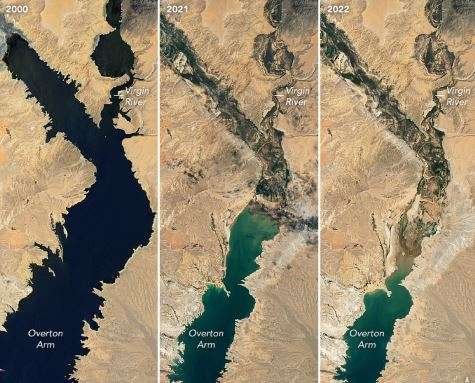Lake Mead Keeps Dropping: A Grim Consequence of Climate Change and Persistent Drought
Unveiling the Alarming Decline of the Largest US Reservoir

Lake Mead, the colossal reservoir supplying water to millions of people across seven states and northern Mexico, continues to suffer from an unprecedented decline. The water levels, as of July 18, 2022, have reached their lowest point since the reservoir’s initial filling in April 1937. This alarming trend is a powerful testament to the devastating impacts of climate change and an enduring drought that could be the most severe in 12 centuries.
Table of Contents
A Disturbing Trend: Lake Mead’s Plummeting Water Levels
The largest reservoir in the United States, Lake Mead, is now filled to just 27 percent of its capacity. This critical water source, serving millions of residents and irrigating vast farmlands, has become a visible symbol of the environmental challenges facing the American Southwest.
A Region in Crisis: Widespread Drought and Dire Conditions
The alarming condition of Lake Mead reflects a broader crisis across the Western United States, where 74 percent of nine states are grappling with some level of drought. Shockingly, 35 percent of the region is experiencing extreme or exceptional drought conditions, with Colorado, the origin of the Colorado River, facing drought in 83 percent of its area. Additionally, the below-average snowpack from the previous winter further exacerbates the dire situation..

Unveiling the Evidence: Satellite Images Reveal the Decline
Comparing satellite images from the year 2000 to 2022, the extent of Lake Mead’s water loss becomes painfully evident. The exposed “bathtub ring” along the shorelines marks previously submerged areas that now stand dry due to the reservoir’s dwindling water levels.
Read: casa do albergado de manaus ( 04.312.401/0004-80 casa do albergado de manaus
Lifeblood of the Southwest: The Role of Colorado River Basin
The Colorado River basin, managed by the U.S. Bureau of Reclamation and other agencies, plays a vital role in providing electricity and water to approximately 40 million people, including major cities like San Diego, Las Vegas, Phoenix, and Los Angeles. Moreover, the basin’s water supports millions of acres of farmland in the region. Established agreements like the 1922 Colorado River Compact allocate water to states and Mexico, forming a crucial lifeline for countless communities.
Impacts on Power Generation and Water Supply
Lake Mead’s plummeting water levels have far-reaching implications, with hydropower generation severely affected. The water elevation at Hoover Dam, as of July 18, 2022, was 1041.30 feet (317.4 meters) above sea level, considerably lower than the elevation of 1199.97 feet (341 meters) recorded in July 2000. To maintain normal turbine operations, lake levels must remain above 1000 feet.
Searching for Solutions: Managing Water Allocations
Amidst the water crisis, the U.S. Bureau of Reclamation announced cuts to state water allocations in 2022. Further discussions and modeling are underway to address allocations for 2023. In June 2022, an emergency request was made to the Colorado River basin states, urging a reduction of water usage by 2 to 4 million acre-feet over the next 18 months.
Recreational and Environmental Impact
Beyond water supply and power generation concerns, Lake Mead’s diminishing waters have significantly impacted recreational activities in the area. Closure of boating ramps and launches due to receding shorelines has affected the National Recreation Area, posing challenges for boaters and visitors alike.
A Call to Action: Addressing Climate Change and Water Management
Lake Mead’s troubling state serves as an urgent call to address climate change and implement sustainable water management practices. To secure the future of this vital water resource and the millions relying on it, collective efforts are needed to combat climate challenges and prioritize responsible water usage.






